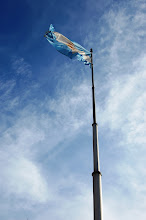Friday, November 6, 2009
riding the colectivo part 1: The Guia-T
Oh, Guia-T. How beautiful you are, with your tiny maps and seemingly orderless grids of numbers. It may look highly complicated at first glance, but the Guia-T (cute Castellano pun: guia-T = guiate = guide yourself….get it? ja.) is quite simple and insanely useful. It’s known as the bible of public transportation here in Buenos Aires, and for good reason: careful reading and interpretation will get you where you want to go, whether your heaven is Palermo, Retiro, or further abroad. But wait! There’s more. The Guia-T can also be used as a regular map if you just ignore the bus numbers, and it’s one that won’t label you an instant tourist. Pulling out a TimeOut or Lonely Planet will automatically mark you as a gringo turista, but whipping out a Guia-T, especially a ragged and well-thumbed one won’t cause much of a fuss…I’ve seen plenty of porteños consulting their Guia-T like it weren’t no thang.
So, how to acquire it. Go to pretty much any kiosk or magazine stand and ask, they’ll probably have one for about 5 pesos or so. Or you can wait until someone on the subte comes around selling them, I’ve seen them on the D-line most recently for 6 pesos (the new fancied-up 2010 version too, very classy.) The routes do change sometimes, so I would recommend using a fairly up to date one. My friend used a 2004 version recently and ended up in La Boca at about 9pm, not the best time for a visit.
Once you have the goods, its time to decipher. First, the front of the book has a zoomed out map of Greater Buenos Aires and its barrios, so you can see where the different areas are in relation to each other. (Btw I’m using the 2009 version, I’m not sure if the 2010 one is laid out differently, but it should be basically the same format). And…the map is actually the right way up, unlike those in TimeOut and other publications that turn the city so that the Plaza de Mayo is at the bottom…highly confusing and quite cartographically inaccurate. In reality, Puerto Madero is the furthest east you can go, with Belgrano up to the north, Boca to the south, and the rest of the city spreading out westwards. But anywho.
After this map is an alphabetical listing of all streets in Buenos Aires. All of them. This is where a colectivo virgin starts.
Step 1: Look up the name of the street you want to start from in the index. Once you find it, if it’s a longer street it will be divided up into segments according to block number. Find which block you are on and then go to the “plano” and specific square that is listed next to it, for example 16 B1.
Each page after this index is a plano, or map. These planos often connect to each other, ie if a road runs off the left of the page, it will say “continúa en el plano blahblah,” and then you just go to the right side of that plano and keep going. An interesting activity if you have an extra Guia-T is to cut out each plano and tape them together in order. I’ve done this (takes ages), but the resulting map is quite impressive; it really shows just how big the city actually is. There is life beyond Almagro people!
Step 2: Once you have your location (ours is 16 B1), find the corresponding square in the grid on the left page. All the buses that run through that particular map square are listed here.
Step 3: Now you do the same thing for the location you want to end up at: find the street, block, plano, and square. Then see if any of the same buses go from your home square to the final destination square. If there is a direct match, ie if the number appears in both squares, skip to the next step. If there are no direct matches, look at the surrounding squares on both planos to find a match--you might have to walk a few blocks to a bigger street. Note: using the Guia-T requires a certain amount of finger dexterity, as you often have to keep two or more plano pages open while also flipping back and forth between them and the route descriptions at the back of the book. Think of it as joint therapy.
Step 4: Once you find a match, turn to the back of the book and find your chosen bus number. Most buses will have two routes, “ida” and “regreso,” although some will have more complicated options such as different ramales or recorridos, but that’s another story. Ida or regreso doesn't really matter, you just have to make sure you get on the route that's going to the place you want to go, not coming from there.
This is where it gets tricky. Nowhere in the Guia-T does it mention where the actual bus stops are. The route descriptions in the back simply list the order of streets down which that particular bus travels, noting only when the bus turns onto a new street or when a street changes names. Annoying, yes, I know, but this is Argentina people, it’s a way of life.
Step 5: Find out which street in your home square the bus travels on. Do this by flipping back and forth between your plano and the description to see which of the streets in your square is mentioned in the description. Once you find it, that’s your street.
Step 6: Then, using the description in the back as a kind of trail guide, follow the route the bus takes. For example, if the description says: “Ave Cabildo, Ave Santa Fe, Ave Puerreydon, Ave Rivadavia,” that means that the bus starts off on Cabildo, which turns into Santa Fe (as you will see in the planos), goes down Santa Fe, turns on Puerreydon, then turns again on Rivadavia. Simple! It will take a lot of flipping at first, and following the streets can be hard sometimes if you don't know which direction they go, but with a bit of trial and error you'll get it!
Step 7: Finding the actual bus stop is a little hit or miss, but basically you just have to walk down the street in the direction the bus will be going until you find it. They tend to occur in groups…there will be stops for a bunch of different routes within the same block, and there will often be either a shelter or a marked pole with the number on it (although this is not a given, especially in the remoter areas of the city look for pieces of paper stuck to trees). There will also probably be a group of people waiting if it’s a popular route, so that should help. Or, when in doubt, just ask someone (donde esta la parada del (#)?) They might know, they might not, but it doesn't hurt to ask!
As you get to know the city better, it will get easier. Eventually you build up a kind of mental repertoire of buses that will get you different places, and you use those to get around. Also, find out which buses run past your house by looking at the various bus stops you see as you’re walking. Then use the Guia-T to look up those numbers and see where they go. That way you’ll have an idea of the different options available right outside your front door! Suerte!
Next up: At the Bus Stop
Labels:
riding the colectivo
Subscribe to:
Post Comments (Atom)








I have to admit a certain fear of the Guia-T (I'm a horrible visual learner!) and this tutorial was quite useful. Also, may I sheepishly admit that I never put the Guiate pun together?? I've only been speaking Spanish for 11 years, clearly these things are easy to miss... (hangs head in shame).
ReplyDelete